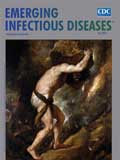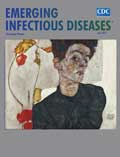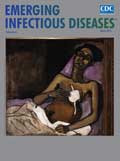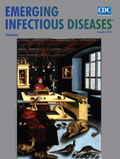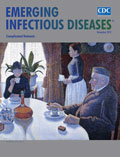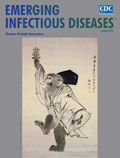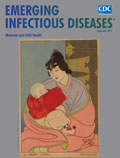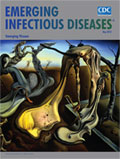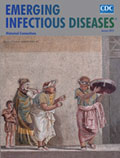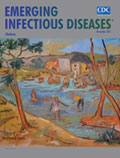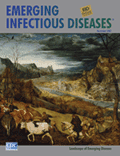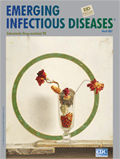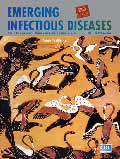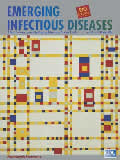Cover Art Audio
Note: To save an audio presentation, right click any "Download MP3" link below and select the "Save Target As..." option.
Volume 19–2013
Volume 19, Number 6–June 2013
More Is More
Download MP3 Length: 1:53
View About the Cover article: More Is More
"My Valley was inspired by my experience of growing up in suburbia, specifically Boise, where the new subdivisions are at the foot of the mountains, built right at the edge of a massive area of what's left of wild America. But as I remember, there was absolutely nothing going on during the day in the suburbs. It was like a ghost town. There seemed to be nothing and nobody around." Jim Barsness captures the nothing and nobody in empty streets, ending in cartoonish cul-de-sacs and cookie cutter houses on their green lawns in the piedmont.
As people move out of metropolitan areas unwittingly encroaching on the wilderness, they are exposed to and come in contact with wildlife. Animals move into human neighborhoods or are brought in through wildlife trade. And this neighborliness back and forth is not without consequences. Humans are exposed to wildlife microbes, which sometimes make the leap from animal to human hosts.
In art, the tension generated by expansive inclusion of elements promotes understanding that may otherwise be lost. Likewise in public health, where an endless supply of unseen creatures, as monstrous and horrific as any found in science fiction, the art of Hieronymus Bosch, or Jim Barsness' imagination, await the opportunity to wreak havoc. Extensive, even obsessive, public health planning is required. "More is more" takes on a new meaning as the wild, the repugnant, and the horrific, meet the banal and the fortuitous in nature.
Volume 19, Number 5–May 2013
Imagining Sisyphus Happy
Download MP3 Length: 1:58
View About the Cover article: Imagining Sisyphus Happy
"And I saw Sisyphus in agonizing torment trying to roll a huge stone to the top of a hill," wrote Homer in The Odyssey. "He would brace himself, and push it towards the summit with both hands, but just as he was about to heave it over the crest its weight overcame him, and then down again to the plain came bounding that pitiless boulder." Sisyphus [Gr. se-sophos=very wise or over wise] may have been the archetypal human competitor of the gods. The story has it that when Death came to take him, Sisyphus tricked and tied him up. As a result, for a time, no one could die, until Zeus intervened.
Rebelliousness and love of life are essential human traits. No less so in public health and disease emergence, an endless cycle. Just as a region gets a solid grip on tuberculosis, populations shift, and the disease reappears. No sooner is a new coronavirus identified and described as SARS than a betacoronavirus with lethal respiratory and renal complications pops up in patients from countries in the Middle East. Lyssavirus, a known culprit, reinvents itself in Spain. Acinetobacter travels from North Africa to France. For all the reasons infectious diseases emerge, they can reemerge, morph into something new, and metastasize. In public health, where monumental effort sometimes brings incremental improvement and success is still measured by tying up Death, public health workers keep pushing the rock up the hill.
Volume 19, Number 4–April 2013
Pale Horse, Pale Rider Done Taken My Lover Away
Download MP3 Length: 1:43
View About the Cover article:
Pale Horse, Pale Rider Done Taken My Lover Away
Despite the scattered character clues, there is one thing we will never know from Schiele's Self-Portrait with Physalis, and that is what would have happened if he had not died at age 28 of pandemic flu. Many strides have been made in flu prevention and control since his death: better understanding of the virus, its distribution in nature, its presence in animals and birds, some of its virulence factors, how it mutates, how it is distributed in tissues, how it is transmitted. We now have prevention programs, vaccines, and antiviral drugs. But many still die, and the threat of another pandemic lurks. Dramatic tension captured in literature and art prevents us from forgetting the dead and the grave pandemics of history. Schiele did his part by immortalizing the faces of his beloved persons—very much like Porter, who in her version of the spiritual "Pale Horse, Pale Rider," she contends that death takes away the singer's lover, mother, siblings, and eventually over the course of several verses the entire family, "But not the singer, not yet," "Death always leaves one singer to mourn." That's to ensure remembrance, which applies as well in public health, where to prevent the next pandemic, it pays to remember and study the past ones.
Volume 19, Number 3–March 2013
Captain Consumption and The Collector of Souls
Download MP3 Length: 1:31
View About the Cover article:
Captain Consumption and The Collector of Souls
In one of her best portraits, T.B. Harlem, Alice Neel painted Carlos Negrón, a Puerto Rican friend, who lived in overcrowded quarters near her studio. His portrait is not just a statement about social ills and contagion. It is also a historical record of tuberculosis and its treatment in 1940. Despite a steady decline in Europe and the United States in the mid-20th century, tuberculosis is still a leading cause of death in the world. Reemergence in the United States in the 1980s and 1990s and continued transmission around the world have been attributed to many factors, among them antimicrobial drug resistance; HIV/AIDS; increased homelessness; and lack of effective treatment programs, as brought home in T.B. Harlem. What Neel felt so acutely and tried to convey in this painting―poverty, malnutrition, overcrowded living conditions―are social determinants, which in the case of tuberculosis, overcame progress in diagnosis and treatment. John Bunyan's "captain consumption" rules until new diagnostics and therapies are aligned with measures to address the social inequities at the heart of reemergence, acknowledging the egalitarian nature of this lethal airborne disease.
Volume 19, Number 2–February 2013
The Iconography of Vermin
Download MP3 Length: 1:21
View About the Cover article: The Iconography of Vermin
La Tour's The Flea Catcher has a mysterious subject. Not so much in its intimacy and introspection but in the discrepancy between these and the mundane task described. The work begs for a contemporary interpretation, one informed by current knowledge of fleas, plague, and human frailty relieved by introspection. Fleas may be some of the most modern insects. Part of their success as vectors comes from their strong, but not absolute, preference for the blood of a good reservoir species, along with a willingness to feed on humans when opportunity and need arise. Fleas that prefer prairie dog blood will feed on and infect a person who wanders through a prairie dog village after a plague-associated prairie dog die-off. This less than desirable feed transforms an unrecognized sylvatic cycle into human illness and death. La Tour's downcast woman is collateral damage to a natural cycle of infection that engages rodent reservoir hosts and the flea vectors. Whatever her emotional situation, it probably had less to do with her worth as a person than with her status in the world, as misfortune generally does. She is as much host of her calamity as of the flea between her thumbs.
Volume 19, Number 1–January 2013
One Rotten Apple Infects All in the Basket
Download MP3 Length: 1:15
View About the Cover article: One Rotten Apple Infects All in the Basket
Pieter Cornelisz van Rijck's Market Scene with Two Figures is a snap-shot of the food genre, a close-up of abundance and prosperity as well as the energy with which food was moved and promoted during the Dutch Golden Age. Market scenes around the world have not changed much, though trade of perishable foods and the urgency to move them from farm to table have changed. Dutch market scenes, the one by Cornelisz van Rijck among them, showed a sense of urgency. Perishables were intended to move as quickly as possible because blemishes and spoilage posed economic risks. Modern food technologies, such as refrigeration, permit a longer travel time. But as refrigerated perishable goods get manipulated en route, new risks are introduced. Pathogens are moving into new food items, modifying and expanding the nature and epidemiologic characteristics of foodborne disease. Despite the differences in emphasis from spoilage to microbiological contamination that causes disease outbreaks, the old rotten apple emblem still applies. Mishandled food from a single manufacturer can still spoil the lot as it raises havoc with the marketplace.
Volume 18–2012
Volume 18, Number 12–December 2012
Why Are We by All Creatures Waited on?
Download MP3 Length: 1:07
View About the Cover article: Why Are We by All Creatures Waited on?
Cardinal Albrecht of Brandenburg as St. Jerome, by Lucas Cranach the Elder, is a type of portrait that borrows the image of a respected person to elevate that of another. Invoking the virtues of the saint in this portrait was the elector and archbishop of Mainz, a patron of artists and intellectuals. An admirer of St. Jerome, he wished to be likened to him, the most learned man of his age. Despite the naturalism so valued in the art of Cranach’s time and his own interest in painting them, the animals in this portrait remain just icons of human values. Stylized and scattered at the feet of the saint, they show none of their individuality or wildness. Images of animals in art have become more refined as humans were able to travel the world, see them in their natural habitat, and study their anatomy and physiology. And the way animals are perceived by humans is now informed by understanding of animal–human phylogenetic closeness and knowledge of the zoonoses.
Volume 18, Number 11–November 2012
Science Avant-Garde
Download MP3 Length: 1:12
View About the Cover article: Science Avant-Garde
La salle à manger, Breakfast is from a series of views inside contemporary interiors. Paul Signac valiantly sought art solutions in the scientific process, the precise observation of color tones in close proximity. And, moving away from the subjectivity of impressionism and the passing moment, he searched the small particles of color for truth. “To ensure optical mixture, the neoimpressionists were forced to use brushwork of a small scale so that, when standing back sufficiently, different elements could reconstitute the desired tint and not be perceived in isolation.” In genomics approaches, likewise, field epidemiologists must use alternative data sources or original techniques to capture the unique characteristics that tie together the epidemiologically related whole. Without these, the bits provided by the precise genomic tools would only create “industrial art,” a canvas without valuable content, aesthetics achieved, in Signac’s words, by “empirical formulae and dishonest or silly advice.”
Volume 18, Number 10–October 2012
Human minus Three Pieces of Hair
Download MP3 Length: 1:07
View About the Cover article: Human minus Three Pieces of Hair
Monkey Performing the Sanbasō Dance showcases Mori Sosen’s favorite subject, monkeys, and his artistic style, a blend of realism and expressiveness. The monkey, mouth pursed with concentration, eyes fixed on some point outside the painting, holds a fan in one hand, and with the other, it raises a cluster of bells. The right leg is lifted in a dance step, while the left, toes curled inward for better balance, is rigid. The monkey lifts the bells in performing a dance celebrating the New Year, the first day of the Monkey Year. Around the world, the status of macaques and their connection with humans continues to evolve. As it lifts up the bells to ring in the New Year 1800, Mori Sosen’s beloved monkey in the flawless kimono continues the age-old dance celebrating our phylogenetic closeness. Because of this closeness, humans and nonhuman primates are susceptible to many of the same infections, minus three pieces of hair or not.
Volume 18, Number 9–September 2012
Riddle in Nine Syllables
Download MP3 Length: 1:13
View About the Cover article: Riddle in Nine Syllables
Paul Jacoulet’s Le Trésor addresses the complex psychological experience of having and being a mother and explored the uniqueness of the experience by capturing facets of maternity in the floating world. Maternal and child health, its own riddle intertwined with pregnancy, features in disease emergence because special populations, pregnant women among them, and their response to emergence are key to successful disease prevention and control. Jacoulet did not know the physical hazards involved in being a vessel. The genetically foreign fetus challenges a woman’s core defense against disease, the immune system, which has to make changes if the pregnancy is to succeed. These changes, not well understood, may alter susceptibility to and severity of certain infectious diseases, among them toxoplasmosis, listeriosis, malaria, measles, and could increase death rates from others, such as influenza and varicella. Hepatitis E virus infections continue to cause a disproportionate number of deaths among pregnant women in developing countries, despite the availability of vaccines.
Volume 18, Number 8–August 2012
Heart Fastened to a Dying Animal
Download MP3 Length: 1:11
View About the Cover article: Heart Fastened to a Dying Animal
Jules Adler’s Transfusion of a Goat's Blood pictured a transfusion in 1890. Dark hair framed the dying maiden’s face against the pillow. A goat was stretched out on an ordinary bench. A history of cohabitation speaks for a far closer connection between animals and humans than the simple rubber tubing in Adler’s painting. This history is celebrated in poetry too, which examines the interface of their health and common fate—the never-ending calamity of death. W.B. Yeats, pondering his own declining health and aging body, was able to see beyond the literal cannula of transfusion. In “Sailing to Byzantium,” the poet conjured the immense damage to the body from illness and physiologic decline. The spirit, which he posed as the way to remain vital in the face of decline, also fuels medical efforts to improve health and prolong life—literally through transfusion and solid tissue transplants and metaphorically when the perennially young human heart finds itself “fastened to a dying animal,” the body.
Volume 18, Number 7–July 2012
Health Threats of All Stripes
Download MP3 Length: 1:37
View About the Cover article: Health Threats of All Stripes
In that each stripe is individually executed to be viewed at once alone and in conjunction with the others, Gene Davis’ Niagara Knife is not unlike public health at the global level. Each laboriously painted thin or thick stripe, each narrow or wide interval, each lyrical color combination a nation; marching bands of color a dazzling array of diversity and separateness; and altogether as Davis intended them, a bright ensemble, a symphony of color, a public health collaboration as spectacular as any bouquet of flowers. “Painting stripe paintings is a vigorous thing,” Davis said about his craft. Laboriously, line by line, the painting becomes an integrated total. The same vigor applies to drafting international regulations, including those intended to protect public health. Outbreak by outbreak, experience with Public Health Emergencies of International Concern delineates what requires international reporting to improve global health and emergency response. Because, while individual stripes are drawn on the canvas of global health as nations agree to report to the World Health Organization events of concern to international health, the total picture is harder to assemble. Distinguishing which events pose international threats is as ambiguous as a Davis painting, and therefore, implementation of the International Health Regulations has not yet realized its full potential.
Volume 18, Number 6–June 2012
I rhyme / To see myself, to set the darkness echoing
Download MP3 Length: 1:37
View About the Cover article:
I rhyme / To see myself, to set the darkness echoing
Gerard van Kuijl’s Narcissus shows the figure in antiquity who fell in love with his own image. The theme has come down to us as narcissism. In one iteration, it overlaps with the myth of Pygmalion, the sculptor, who fell in love not with his image but with his work. We have now succeeded in recreating our image not only in art but also in the flesh. A more resilient human with healthier and longer lasting parts is the reflection we look for in the well, a reflection too of improved medical knowledge, expertise, and technology: properly used antimicrobial drugs; preventive screening; and growth hormone and dura mater grafts from cadavers. The history of medicine is filled with unintended consequences. A concern since the time of Hippocrates, “to do no harm” is a continuing chapter with contemporary examples: Reliance on a single class of antimicrobial drugs heightens our vulnerability to emergence of resistance, requiring more treatment options. On the other hand, current tallies of Creutzfeldt-Jakob disease incidence identified no new sources of disease, indicating that current practices should minimize the risk until blood screening is validated for human use and suggesting that, despite setbacks that make that glimpse of perfect self fatal, science diligently applied can still set the darkness echoing.
Volume 18, Number 5–May 2012
Health and the Myrmidons
Download MP3 Length: 1:27
View About the Cover article: Health and the Myrmidons
Salvador Dalí’s Daddy Longlegs of the Evening?Hope! was inspired by war and contains imagery that recalls its darkness. The Myrmidons (ant-men) were a prolific warrior race patterned after ants from whom they allegedly descended by divine transformation. The term still evokes somehow the ants of origin?the same plentiful arthropods Dalí sprinkled liberally in his works?their glistening bodies clustered around the edges, foreshadowing decomposition. Among health threats, viruses are like the Myrmidons in their sheer numbers. Even though several thousand have been identified, the large masses remain at large. With each new identification, the public health burden increases. This is where Dalí would insert daddy longlegs. For with each identification, the opportunity also arises for new vaccines or other prevention strategies and effective treatments, as in the case of many known viruses, including the formidable HIV. Like a surrealist painting, emergence of viruses around the globe features realities that by all appearances have nothing to link them, often in settings that by all appearances are not linked. The challenge is in identifying and controlling the Myrmidons, one by one.
Volume 18, Number 4–April 2012
Military Magic or Nature's Fool
Download MP3 Length: 1:24
View About the Cover article: Military Magic or Nature's Fool
Camouflage, one of two surviving studies from Charles Burchfield’s military days, is a mix of abstract and realistic elements and like all his work reaches for more than meets the eye. Crude forms of camouflage have been used in warfare since antiquity. When the United States entered World War I, a number of artists, Burchfield among them, became involved, producing various patterns, initially representational then boldly abstract. When cubism swept the art scene, obliterating the distinction between an object and its background, it influenced military camouflage designs. The merger between art and nature sensed by camouflage artists has broad applicability in disease emergence, where the borders, geographic and biological, blend as smoothly and seamlessly as in art. A look at the ecologic dynamics, meteorologic variables, and transmission cycles, along with human travel and vector control of malaria alone as it reemerges around the world, attests to Burchfield’s acute understanding of complexity underneath the surface. But, while artists and the military have managed to fool human enemies by camouflage, we have yet to adequately fool mosquito and other vectors of disease.
Volume 18, Number 3–March 2012
The Shortest Follies Are the Best
Download MP3 Length: 0:54
View About the Cover article: The Shortest Follies Are the Best
As naturalistic as Paulus Potter’s God Appearing to Abraham at Sichem might have been intended, it seems idyllic to us. Not that the milk cows, goats, and other animals seem out of place or that divine promise is no longer needed. What is missing is the zoonotic touch. Many infections plague animals harvested as food and the humans who rely on them. Unpasteurized dairy products, for example, continue to be associated with outbreaks in the United States. For reservoirs and interspecies transmission of highly pathogenic agents, the relationships between humans, other animals, and the environment remain difficult to understand and control. And, despite public health efforts, long follies persist for lack of adequate study or application of existing epidemiologic and biomedical tools.
Volume 18, Number 2–March 2012
Memory as Medicine
Download MP3 Length: 1:17
View About the Cover article: Memory as Medicine
“I’ve always felt like the only way I can heal myself throughout certain things is to go back through my memory, learn from memory.” This travel through memory seems pertinent to Radcliffe Bailey’s En Route, which uses symbolic elements (Water, the boat, blue color, tropical imagery, navigational tools) to examine slavery’s Middle Passage in the journey from Africa to a final destination. Layers of cryptic historical data feature too in science and are as essential to appreciating it as those of any painting in any era. Much has been learned, for example, about pandemic influenza from examining the 1918 pandemic. And not just by revisiting it. Like the artist, public health practitioners are constantly reevaluating the pandemic, not quite knowing where new outlooks might take them. We benefit from reviewing old scourges: slavery, cholera, influenza. Each time we revisit them is like revisiting the art museum to see the old masters. We see something new. Not because the old masters have changed so much but because with new knowledge and outlook, we have.
Volume 18, Number 1–January 2012
Tough Art and Microbial Drama
Download MP3 Length: 1:15
View About the Cover article: Tough Art and Microbial Drama
Musici Ambulanti, found in the ruins of a structure known as the Villa of Cicero near the city of Pompeii, is one of the finest examples of ancient mosaic making. Signed by Dioskurides of Samos, known to us only from mosaics bearing his name, the panel shows three actors wearing masks and performing as musicians. “Painting in stone,” as mosaic making has sometimes been called, is painstaking and technically demanding, particularly in its inspired form, which combines seamlessly and in complete balance color, light, and rhythm. Unlike mosaics, which owe their resilience to the inflexibility of their medium, microbes often owe their persistence to extraordinary flexibility brought about by genetic plasticity and a short life cycle. When their genes divide, the offspring are unlike their parents in ways that may make them survive or cause disease more effectively. They adapt quickly and remain with us throughout the ages. Like the acting musicians in Dioskurides’ mosaic, they play and they dance to their own rhythm, masked, compelling, and impervious to the march of time.
Volume 17–2011
Volume 17, Number 11–July 2011
Persistence of Memory and the Comma Bacillus
Download MP3 Length: 2:02
View About the Cover article:
Persistence of Memory and the Comma Bacillus
The Bathers, painted by Haitian artist Georges Desarmes, provides a glimpse of life on the Artibonite River and the bordering communities before the 2010 cholera outbreak. In The Bathers, the artist captures the ease and communal charm of living along the river bank lined with tiny homes and populated with locals relating to each other on a personal level as they cool off. The scene is lyrical, spare, sunny, pre-cholera. On this day, this is the center of the universe, and this is the life. The artist captures the gist of it in a way only an impressionist could.
Refusing to recognize false boundaries, cholera encompasses the frailties of political conflict and the aftermath of mass travel and increased human contact. Since no outbreaks were seen in the Caribbean since the mid-19th century, it was said that Haiti had no memory of or experience in handling cholera. But the memory was there: Ships pull in harbors with unknown pestilent cargo. Sanitary conditions are not optimal. Contraband microbes hop off and settle in new areas among populations with no immunity or infrastructure to prevent rapid spread of disease.
Desarmes’ lyrical impression of the waterfront meets the concept of involuntary memory, in which everyday cues evoke recollection of things past. But human history benefits more from voluntary memory, a deliberate effort to recall the past. Unless that happens, no one should be surprised if an inconsequential microbe causing a preventable and treatable disease continues to kill so many people.
Volume 14–2008
Volume 14, Number 1–January 2008
"I Am but Mad North-northwest: When the Wind is Southerly I Know a Hawk from a Handsaw"
Download MP3 Length: 2:00
View About the Cover article: "I Am but Mad North-northwest: When the Wind is Southerly I Know a Hawk from a Handsaw"
Quest for Avuk captures a theme of everyday life. Eskimo men paddle a lightweight skin boat of the Arctic, searching for Avuk, likely a walrus. The men in camouflage kuspuks of cotton canvas over their parkas wear a look of intense concentration. A rifle, a toggling harpoon, and a sealskin float are visible from the side. The lithe vessel gliding noiselessly on the frigid waters allows immediate access to the hunt beneath the surface: seals, walruses, whales; in back, ice always in the invisible horizon.
"I have only my song, / Though it too is slipping from me." Arctic populations in the United States and Canada now live largely in settled communities no longer completely dependent on walrus and fish. Long adapted to isolation and affected by infections linked to climate and culture, they are now also vulnerable to emerging plagues. Back in the 1980s, in his "Trees at the Arctic Circle," Al Purdy contemplated the strength of these trees: "And you know it occurs to me / about 2 feet under / those roots must touch permafrost / ice that remains ice forever / and they use it for their nourishment / use death to remain alive." Now permafrost is melting. Heavily geared for ice, Arctic populations are facing yet another bout of rough weather, a warming trend. And unlike Shakespeare's hero, they have no need to feign madness.
Volume 13–2007
Volume 13, Number 11–November 2007
The Panoramic Landscape of Human Suffering
Download MP3 Length: 1:43
View About the Cover article:
The Panoramic Landscape of Human Suffering
Bruegel, intrigued by the workings of nature, turned away from idealized landscapes. Familiar with the common people, he translated moralizing and proverbial tales into vernacular earthy scenes infused with humor and whimsy. Return of the Herd has a circular rhythm linking the foreground with the background, the ritual return of the herd with mountains and gathering clouds. Winter is just around the corner. Humans and animals head for cover. The fertile metaphorical terrain, with its rich tonal variations, rhythmical movement, and insuppressible aura of death and regeneration, without parallel in the 16th century, may have found its match in our times. The landscape of emerging infections?broad, diverse, and fueled by human activity?rivals Bruegel’s in geographic expanse, topographical detail, and the threat of unrelenting human hazard: antimicrobial drug resistance, violent conflict, HIV/AIDS, vector-borne infections, epizootic (H5N1) and pandemic flu, ecologic disasters, community- and hospital-acquired infections. Human suffering, as W. H. Auden put it, so well understood by the Old Masters, continues unabated, “…in a corner, / some untidy spot / where the dogs go on with their doggy life and the torturer’s horse / scratches its innocent behind on a tree.”
Volume 13, Number 3–November 2007
The Way Forward Is the Way Back
Download MP3 Length: 2:06
View About the Cover article: The Way Forward Is the Way Back
"All forms of beauty, like all possible phenomena," wrote Baudelaire, "contain an element of the eternal and an element of the transitory—of the absolute and the particular." In a perfect balance of feeling and form, Francisco Roa's poignant scene meets Baudelaire's requirement. For nothing expresses the ephemeral better than flowers. Roses or sand verbenas, they perish all too soon, a metaphor for human transience and fragility. The eternal and the absolute are elements artists have sought in the formalities of realism and the fragments of abstraction, on the same pathway, one step forward, two steps back; and scientists likewise, for rarely does excellent science or art occur without reference to past knowledge and principle.
In Sands Flowers, Roa probes the precariousness of existence, space and time, life and death. His realistic representation of natural objects in decline provokes speculation—not only on the passage of time and inevitability of death, but for us also on disease, which unduly hastens the process. In an unending circle, old scourges become new, among them tuberculosis, a hornet's nest of multiple drug resistance, and now extensive resistance to second-line drugs, raising the specter of potentially untreatable disease. Roa sought essence in the staying power of exacting detail. In science too, on the same pathway, sometimes solutions lie simply in the core values: treatment standards; effective precautions; improved technology; and better medicines, vaccines, and diagnostic tests.
Volume 12–2006
Volume 12, Number 10–October 2006
Πάντα ῥεῖ καὶ οὐδὲν μένει
Download MP3 Length: 1:34
View About the Cover article: Πάντα ῥεῖ καὶ οὐδὲν μένει
No other painting captures Renoir's joie de vivre and conviviality better than Luncheon of the Boating Party. He worked on the complex composition for months. The gathering took place near Chatou, his favored retreat on the Seine. The luncheon is finished. The crowd "hangs out" against the clutter of leftover food and drink, gracing the intimate tableau all of us want to be in. Just beyond the awning, the river flows discreetly in the background. Soon, it will turn dark, the crowd will disperse, the moment will end. The moment and its transient place in constant change, so well understood by the impressionists and masterfully captured by Renoir, have also puzzled philosophers and scientists and are central to the study of emerging disease. In a world where “everything flows,” organisms and their surroundings are constantly changing, and “nothing stands still,” vigilance is order of the day. Disease control is as good as the next set of natural circumstances, for as Herakleitos of Ephesus put it 2500 years ago, “You cannot step twice into the same river, for fresh waters are ever flowing upon you.”
Volume 12, Number 2–February 2006
Host-Pathogen-Venue Combinations and All That Jazz
Download MP3 Length: 1:50
View About the Cover article:
Host-Pathogen-Venue Combinations and All That Jazz
Nightlife, one of Motley's most celebrated works, is a glimpse of the action at a dance hall in Chicago. Painted during World War II, the picture does not address the dire global circumstances. It focuses instead on a lighthearted moment of gaiety, inside a comfortable establishment, vibrant with the sounds of music, dancing, and conversation. A lively jazz band in the background guides the figures. Diagonal lines indicate sharp syncopated movement amidst free-flowing activity around the dance floor. Even as Motley focused on the moment's thrill inside a nightclub, he created a microcosm analogous to broader outside reality, an allegory of the world. The stylish crowd socializing and the jazz band orchestrating their movements mirror the group dynamics of microbial populations, swinging to nature's tune in niches they make for themselves. The spontaneity of jazz music and its adaptations to local culture over time around the globe parallel the emergence and export of new diseases from their seedbeds to audiences the world over. A glance at Emerging Infectious Diseases contents confirms the immense diversity of disease emergence over time and place, from birds with flu and Helicobacter infections to drug-resistant HIV strains, from Nipah virus to Arcobacter, from dengue to ameba-associated pneumonia. All neatly choreographed to music we cannot yet hear.
Volume 12, Number 1–January 2006
Painting Nature on the Wing
Download MP3 Length: 1:43
View About the Cover article: Painting Nature on the Wing
"Good metaphor," noted Aristotle in his Poetics, "implies an intuitive perception of the similarity of dissimilars." The metaphor implies likeness. A bird is not human, but a single element in its appearance can invoke humanity, just as a single element in a plant's appearance can distinguish its species. Winslow Homer's masterful Right and Left, a hunting scene commissioned as a sporting picture, is much more. In a few brushstrokes, the artist delivers the ocean's power, the vastness of creation, conflict in the world, riddles in nature. He projects the birds and their plight, the hunter's unimportance, even as he fires the fatal shots. The ambiguity in their posture is the artist's ambivalence about which bird died first. The threat is imminent and inevitable. Death is certain. The artist's vision holds yet more ambiguity today. The sporting ducks deliver as well as receive havoc. When they escape the double-barreled shotgun and fly off, they may carry with them nature's revenge, introducing new flu virus strains right and left: to domestic animals or directly to humans, increasing risks for new pandemics. As we stare into the hunter's barrel in Homer's painting, we could be the sitting ducks.
Volume 11–2005
Volume 11, Number 10–October 2005
Of Tidal Waves and Human Frailty
Download MP3 Length: 1:59
View About the Cover article: Of Tidal Waves and Human Frailty
In The Great Wave, Hokusai captured the uneasy sentiments of a nation surrounded and defined by water, as well as the deeper, primal, human terror of the sea. Enchanting but treacherous, water lures and repels. Seeking livelihood, fortune, adventure, or just solace in its calm, humans ride the waves, risking capricious tempests, settling in precarious coastal regions frequently battered and overpowered by the sea. When the earth moves or climate and other elements stir the waters, environmental markers shift, boats and settlements crumble, and humans perish. In the aftermath comes infectious disease, originating in the disruption and lingering for lack of hygienic conditions and adequate medical care.
Hokusai's fishermen typify human plight against overwhelming force. Their posture embodies the horror of imminent physical harm and death. Fear and anxiety about the long-term consequences of environmental catastrophe are left to survivors and public health workers, who face, along with the loss of infrastructure, compromised sanitation, contamination of water supplies, secondary wound infections, unsafe food, increased poverty, and compounded disease. The formidable challenge of water-related illness and death persists, from the Indian Ocean to the Gulf of Mexico—despite global prevention and control efforts. Like the fishermen caught in Hokusai's wave, unable to confront the culprit, we cling to a lifeline: managing the physical trauma and addressing resultant infections and complications.
Volume 11, Number 8–August 2005
Ancient Myths and Avian Pestilence
Download MP3 Length: 1:49
View About the Cover article: Ancient Myths and Avian Pestilence
Resistant to slings and arrows and prone to long-distance migrations, birds such as the ones on this ancient amphora persist beyond our ancestors' morbid imaginations. Not because of mythical metal paraphernalia but for their explosive potential as natural reservoirs and amplifying hosts of pathogens. Viremic migratory birds acting as introductory hosts may have brought West Nile virus to the Western Hemisphere, perhaps by infecting ornithophilic mosquitoes, which may have infected amplifying hosts and eventually humans.
Migratory waterfowl (ducks, geese) also carry flu viruses in their intestines and shed them in their secretions and excretions. As these waterfowl migrate around the globe, they introduce new flu strains into domestic poultry and swine. These strains can then amplify and mutate close to human populations, increasing the risk that the virus will recombine with local human strains to form a new virus with pandemic potential. Like the legendary harpies, these new strains, half human half avian, pose an immense public health challenge. We now know more about bird pestilence. West Nile virus infection and avian flu are just as ominous as razor-edged feathers. And while Herakles had krotala from the gods, we must work with human tools: repellants and pesticides, vaccines, antiviral drugs, or medical isolation and quarantine.
Volume 11, Number 1–January 2005
Genre Painting and the World's Kitchen
Download MP3 Length: 1:42
View About the Cover article: Genre Painting and the World's Kitchen
"Tell me what you eat, I will tell you who you are," boasted famed gastronome Jean Savarin. In nature and on the table, quite apart from its direct link to human survival, food has been an object of intrigue featured prominently in art throughout history. From ancient times and particularly during the development of genre painting in the Middle Ages and later, food—its appearance, abundance, or decay—has been a popular subject. In An Old Woman Cooking Eggs, Velásquez painted the food preparers removed and distant from the food and from each other. They go through the motions of cooking, but their minds are elsewhere. In their day the main concern in the kitchen was the availability of food.
An ancient staple, eggs have run the gamut from plentiful protein to gourmet delicacy. Yet, basic food and epicurean aspirations converge at one point: safety. With high levels of Salmonella Enteriditis in shell eggs, adequate cooking and proper temperature of the eggs overrule tradition, challenging the consistency of the sauce and the moment of delivery to the table. In our times, safety issues concerning not only eggs but all foods beg a different interpretation of another well-known Savarin aphorism, "The destiny of a nation depends on the manner in which it feeds itself."
Volume 10–2004
Volume 10, Number 12–December 2004
"One Medicine" for Animal and Human Health
Download MP3 Length: 2:03
View About the Cover article:
"One Medicine" for Animal and Human Health
In a world marred by strife—between nations, between animals and humans, between animals themselves—Edward Hicks tapped into the universal wish for harmony and peace. Well ahead of his time, he invited to his kingdoms not only leading human figures and innocent children but also a consortium of animals whose presence he found indispensable. The animals, whose anthropomorphic features betrayed human emotions, seemed puzzled and apprehensive. In the dander and under their breath, in the soil and in the water, on the leaves and the clothing of the dignitaries, lay creatures unknown to Hicks, microorganisms, insidiously moving from animals to humans, eating, multiplying, sharing, spreading, connecting.
Not long after Hicks' death in 1849, German pathologist Rudolf Virchow (1821–1902) coined the term zoonosis, verifying the essential link between animal and human health. This link, further complicated by the emerging nature of disease and the ethical, ecologic, social, and economic values placed on the relation between humans and their pets, livestock, or fellow inhabitants of nature, has not been uniformly acknowledged or exploited—even in the face of AIDS, Ebola, West Nile virus and avian influenza, and SARS. In the 1980s, American epidemiologist Calvin Schwabe proposed a unified human and veterinary approach against zoonotic diseases. This approach, "one medicine," upholds Virchow's principles and affirms Hicks' wish for the control of subversive elements, whether they interfere with harmonious animal and human interaction or they disrupt animal and human health.
Volume 10, Number 10–October 2004
Molecular Techniques and the True Content of Reality
Download MP3 Length: 1:38
View About the Cover article:
Molecular Techniques and the True Content of Reality
Mondrian traveled to Paris, where he met Georges Braque and other leading artists and was exposed to the abstracting qualities of cubism. His work in Paris culminated in a new art movement known as neoplasticism. The term was coined by a Dutch mathematician and friend of Mondrian's. "Plastic" referred to a formal structure underlying everything in nature. In abstract art, distracting elements around this structure were removed, leaving fragments of objects or, in Mondrian's work, black bands and color rectangles. The challenge was to find, out of infinite possibilities, the right relation between these bands and the rectangles they formed. The equilibrium Mondrian sensed in the universe and sought in radical abstraction is well known to biologists. Modern molecular techniques, stripping organisms of all but their genetic base, array clumped fragments—DNA fingerprints—the biologist's version of Mondrian's grid. The fragments, used to type and characterize agents such as Pneumocystis jirovecii, causative agent of Pneumocystis pneumonia, provide scientists a glimpse of pure reality, along with information on sources of infection, patterns of transmission, and potential emergence of antimicrobial resistance.

